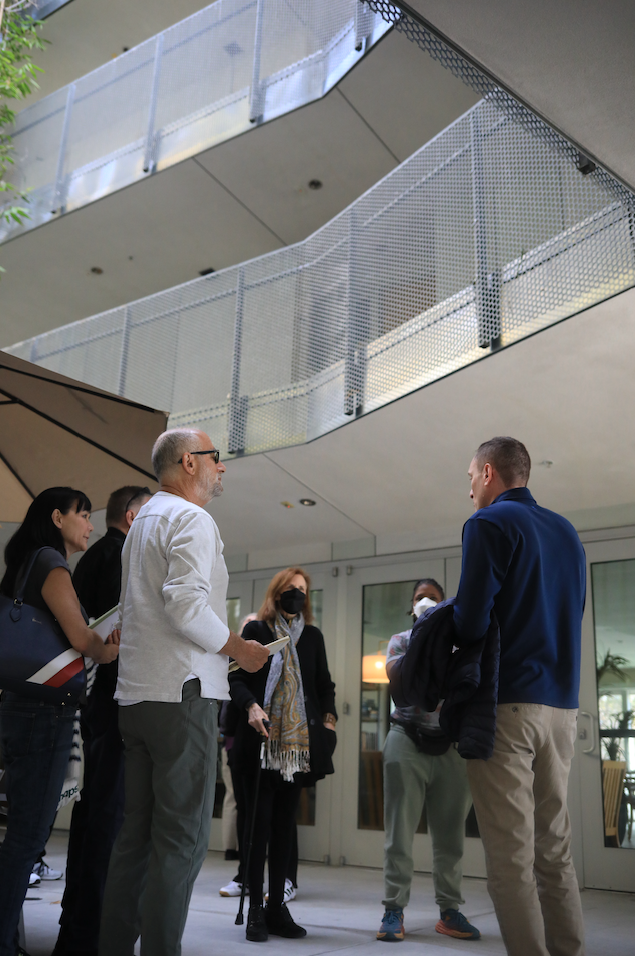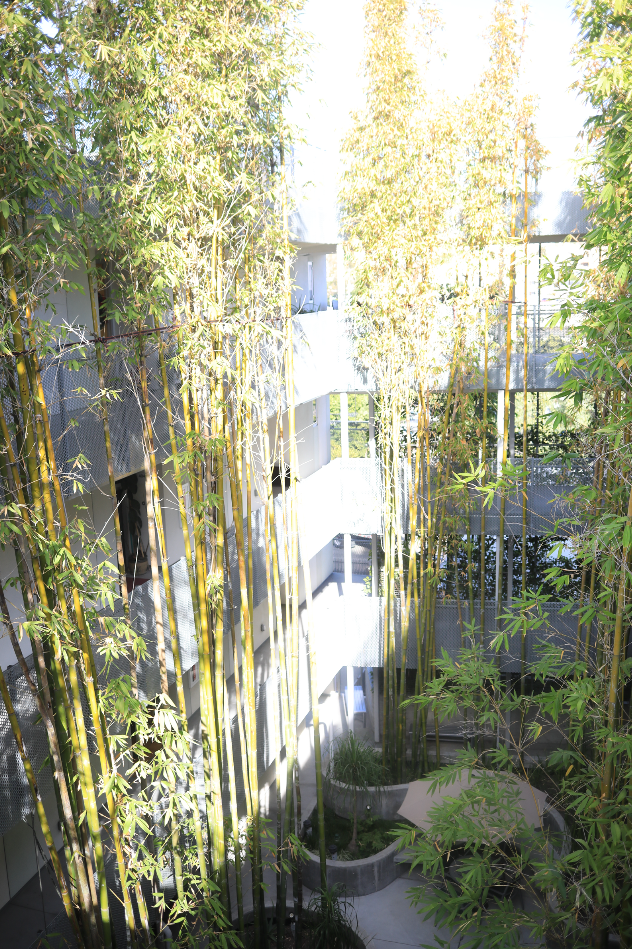
A mix of WeHo commissioners and boardmembers toured several properties owned and operated by the West Hollywood Community Housing Corporation this weekend, learning more about the nonprofit organization that builds and renovates affordable housing sites in the city and throughout Southern California.
President/CEO Jesse Slansky led the Saturday morning tour, providing about a dozen city officials with background on WHCHC while exploring the properties and meeting residents. Councilmember John Heilman, who Slanksy called “instrumental” in the corporation’s creation, also accompanied the tour.
“One of our first actions was to develop the rent control or rent stabilization ordinance,” Heilman said. “But we knew that wasn’t going to be a solution for everyone in terms of affordable housing, particularly for people who are unable to work because of disability or those unable to work at the time, as that was really the beginning of the AIDS epidemic. So, we needed permanent affordable housing.”
The West Hollywood Community Housing Corporation (WHCHC) was established following the cityhood of West Hollywood in the 1980s, formed in response to concerns from senior citizens and the LGBT community about rapid urban development and potential changes in rent control laws. The organization began with the refurbishment of existing structures due to the limited availability of vacant land in West Hollywood, and this expanded to include the construction of new housing units.
Slanksy explained the corporation’s funding model — known as a low-income housing tax return —through an analogy.
“We apply for an allocation of federal tax credits. We then sell those credits to an investor and use that money to build a building. Imagine if you got a $100 gift card to a store you absolutely hate. Maybe you’re not a knitter and you get a gift certificate to Joann Fabrics. So, if you sell that to somebody for $95, it’s like a win-win, right? You have $95 in cash to use wherever you want, and they have $100 to spend at Joann Fabrics, their favorite store. They get a little discount. That’s sort of how our program works in essence.”
WHCHC has developed more than 21 rental apartment communities, housing over 1,200 residents, primarily those living below the federal poverty line. Its approach to housing development focuses on high-density, urban infill development, integrating new housing units within existing neighborhoods. Initial projects involved the acquisition and renovation of older buildings, followed by the rehabilitation of smaller bungalows and the addition of new units in the early 1990s. This evolved into the development of entirely new construction projects.
On Saturday, the group visited the Courtyard at La Brea, the Blue Hibiscus on Detroit and Hayworth House on North Hayworth.
The Courtyard contains 31 units serving a mixed population of very low and low incomes, including families and people with special needs, and one manager’s unit. The project is comprised of two mid-rise residential towers enclosing a central courtyard which is open to the south; an interior bamboo courtyard and a community garden at the rear of the property.
Blue Hibiscus includes 22 units of affordable rental housing and was awarded LEED Platinum for environmental sustainability. A percentage of the units are specifically reserved for those with special needs, such as transition-age youth, people with a mental health diagnosis, and people living with HIV/AIDS. Blue Hibiscus began as a set of bungalows before its transformation in the complex it is today, and WHCHC was able to offer the formerly dislocated residents homes in the new building.
“So we went from a small, functionally obsolete property that was really hard to maintain, that didn’t have any facilities for aging in place and communications, to now more than doubling the amount of housing stuff here in the city,” Slanksy said.
Hayworth House is a major green renovation of a 1950s apartment building. This West Hollywood apartment building was neglected and became a neighborhood nuisance. Hayworth House was purchased in May 2009 by WHCHC and underwent a significant green modernization over the years, including upgraded HVAC systems as well as completely refinishing the original oak hardwood floors.
WHCHC took great care to maximize ADA accessibility and livability for residents and reduce the carbon footprint of the building. Accessibility was also enhanced with the removal of steps needed to access first floor apartments. Amenities include a sunny, spacious community room, two new elevators, a laundry room, a TV room and a computer room. In addition there is a raised-bed community garden, a zen-like rock garden as well as a backyard gathering space perfect for relaxation. Exterior courtyards and a spacious front porch were also added to give each resident an added personal comfort of home.
The commissioners were surprised by the tranquility of all three properties, and impressed by the rooftop terraces and omnipresent gardens throughout each property.
WHCHC’s apartment communities, which vary in size from eight to 100 units, are designed to be environmentally sensitive and architecturally integrated with their neighborhoods. The residents of these communities include a diverse mix of seniors, families, individuals with special needs, people with mental illness, chronic health conditions, HIV/AIDS, members of the LGBT community, the homeless, and transition-age youth. Access to affordable housing through WHCHC provides these residents with increased security and stability.
















These properties are so very much needed. My own social security check just makes my rent. No monies left over for food etc. WHCC please keep up the good work. There’s many thousands of seniors that are like myself
A percentage of the units are specifically reserved for those with special needs, such as transition-age youth, people with a mental health diagnosis, and people living with HIV/AIDS. Blue Hibiscus began as a set of bungalows before its 2048 cupcakes transformation in the complex it is today, and WHCHC was able to offer the formerly dislocated residents homes in the new building. So we went from a small, functionally obsolete property that was really hard to maintain, that didn’t have any facilities for aging in place and communications, to now more than doubling the amount of housing stuff here in the city,”… Read more »
They’re very attractive. I moved onto Hayworth in 2009. It’s still a good looking building.
Good for John H. Smart move.
Oh look Jeff Slanksy schmoozing our leaders right before the appeal on the scandalous Wetherly Palms project comes before the city council. Nothing nefarious here.
The appeal for the Wetherly project is heard by Council, not by Commssioners nor by Advisory Board members.
One Councilmember on the tour. Only one.
You did get one thing right, though – nothing nefarious here.
One weeks pay for one months stay! We have a baseline for wages but not accommodation. This makes no sense and simply doesn’t work. The average lowest rent in 2022, ranged from $1,200 to $1,500 per month in many places. The monthly income, based on the federal minimum wage of $7.25 per hour for a full-time job of 40 hours per week, which amounts to around $1,256.96 per month before taxes. HUD’s Definition of Affordable Housing: The U.S. Department of Housing and Urban Development (HUD) defines housing as affordable if a household pays no more than 30% of its income… Read more »
There has never been a bigger mismanagement of money in this city than Blue Hibiscus. They knocked down 12 bungalows to put up a 22 unit building. When I went to grand opening I was told it cost over $15 million. That’s $15 million to house nine new people, since one unit is for a staff person to live in. The rooftop common room is fancier than any set for any cooking show you’ve ever seen. What could be another unit to help someone is a gym, why not just make a deal with LA fitness for tenants that want… Read more »